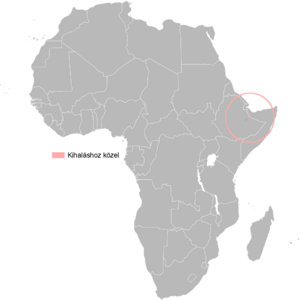Archer's lark facts for kids
Quick facts for kids Archer's lark |
|
|---|---|
| Conservation status | |
| Scientific classification | |
| Genus: |
Heteromirafra
|
| Species: |
archeri
|
 |
|
| Synonyms | |
|
|
The Archer's lark (Heteromirafra archeri), also called the Liben lark, is a type of lark bird. It lives in Somalia and Ethiopia. This bird prefers dry shrubland and open grasslands. Sadly, it is in danger because its habitat is shrinking. The bird's name honors Sir Geoffrey Francis Archer, a British explorer.
Contents
What is Archer's Lark?
Its Scientific Name
The Archer's lark is scientifically known as Heteromirafra archeri. Some people used to think it belonged to a different group of larks called Mirafra. Another lark, the Sidamo lark, was once thought to be a separate species. Now, scientists believe it is the same as the Liben lark.
How to Spot an Archer's Lark
Appearance and Size
The Liben lark is about 14 centimeters (5.5 inches) long. It has a fairly large head and a short, plump body. Its belly is a light, buff color. The chest has streaks of darker color. Most of its feathers are brown and reddish-brown. It has a short, thin tail that is brown with white feathers on the sides. We don't know what its call sounds like.
How Archer's Larks Behave
Daily Habits
These birds mostly stay on the ground. They are quite shy and hard to spot. Even though they can fly well, they often choose to hide in plants.
Nesting and Young
Archer's larks build their nests in the summer. A female lark usually lays three eggs at a time.
What They Eat
Their diet probably includes seeds. They also eat small insects and worms.
Where Archer's Larks Live
Their Home Environment
Archer's larks like open grasslands and rocky areas. These places have tall, clumpy grasses. They need areas that get about 300 to 400 millimeters (12 to 16 inches) of rain each year.
Where They Are Found Today
The total area where Liben larks can be found is very small. It's only about 52 square kilometers (20 square miles). Most of this area is in Ethiopia. These birds have not been seen in the Wajaale clay plains near the Ethiopia-Somalia border since 1922. Because their habitat has been lost, Archer's lark has not been found in Somalia since at least 1970.
Saving the Archer's Lark
Its Current Status
Scientists believe there are only about 50 to 250 adult Archer's larks left. This is because many searches since 1955 have not found many birds. One of the last possible sightings was in Ethiopia in 2003. In 2005, the species was declared critically endangered. This means it is at a very high risk of disappearing forever. A special program has started to help protect and restore their grasslands.
Recent Sightings
In 2011, a bird watching group saw a bird that might have been a Liben lark. This happened in north-eastern Ethiopia. They took a photo, which scientists are studying to confirm if it was indeed an Archer's lark.
Main Dangers to the Lark
Human activities are causing the loss of important grassland for the Liben lark. This is happening in the Negele plateau. For example, Acacia drepanolobium bushes are growing into the grasslands. Also, efforts to stop fires since the 1980s might have made the problem worse. Fires used to help keep the grasslands open.
More people are moving into the region. This is causing a shift from moving with animals to permanent farming. This change is a big threat to the lark. Also, a new watering spot in the bird's main area has brought many farm animals. This causes too much grazing and damages the habitat.
The Liben lark's home continues to get worse. This is likely due to too much grazing and grasslands being turned into farms. Between 2010 and 2011, a large part of the Liben Plain grasslands was lost to farming.
In the past, people living in refugee camps in Somalia also damaged the lark's original grassland home. Even though those people have left, intense farming, grazing, and habitat damage continue. New settlements, fires, and plants that don't belong there also add to the habitat loss. All these things threaten the Archer's lark's survival.


